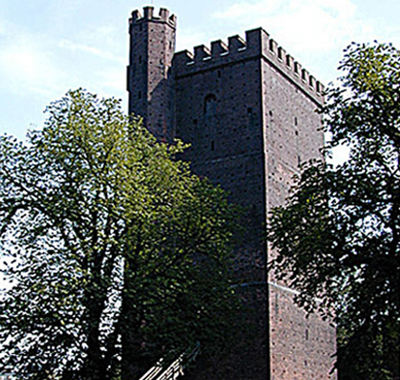| Middelalderbyen

| | Kärnan i Helsingborg. Det første borgkompleks var cirkelrundt og er markeret ved siden af tårnet.
I 1310 lod Erik Menved opføre et nyt kærnetårn til borgen. Dette blev kvadratisk med meget kraftige mure. Tårnet er over 30 meter højt. |
Borgbyggeri
Et synligt vidnesbyrd om de urolige og omskiftelige tider omkring år 1300 var kronens anlæggelse og fornyelse af en række borganlæg rundt omkring i regionen.
Ved Helsingborg afløstes det oprindelige cirkulære tårn med det firkantede og 30 meter høje Kärnan. Denne tårnbygning blev en massiv og sværindtagelig borg. Den nederste del af tårnet var således over 4 meter tyk. Et forsvarsanlæg der kunne stå mål mod tidens selv stærkeste våben. Arbejdet blev iværksat omkring 1310, i Erik Menveds tid, hvor også Falsterbohus og Lindholm længere sydpå i Skåne blev udbygget og forstærket. Falsterbohus fik også et kvadratisk kernetårn og det samme var tilfældet med Lindholmes borg ved Börringesjön i det sydlige Skåne. Falsterbohus overtog efterhånden Skanørborgens opgaver og Helsingborg, med det nye Kärnan, udviklede sig til at blive kronens vigtigste forsvarsværk i Skåne.
På Bornholm udvikles Hammershus efterhånden til det største borganlæg i Norden. I Vordingborg på Sydsjælland opføres et borgkompleks til forsvar af landets sydgrænse og i Kalundborg på Vestsjælland udbygges Esbern Snares gamle borganlæg. Endelig opføres i Nordsjælland i Valdemar Atterdags tid(1340-1375) et administrativt centrum med et centralt borganlæg ved Gurre.

Borge før 1400 | 
Kärnan, Helsingborg | 
Kärnan i snit | 
Kärnans indre | 
Hammershus |

Gåsetårnet. | 
Vordingborg Slot. | 
Borganlæg | 
Gurre Slotsruin | 
Gurreudgravning |

Gurrekompleks | 
Gurre Slot |
Kalmarunionen og købstædernes vækst
I slutningen af 1300-tallet er Skånemarkedets betydning vigende og handelen flytter bort fra Skanør og Falsterbo til bl.a. Malmø og København, der nu kunne byde på et større opland og mere købedygtigt publikum. Hen imod slutningen af århundredet manifesterer Norden under Kalmarunionen (1397) med Margrethe d.1. i spidsen modstand imod hansestædernes økonomiske dominans og under Margrethes arving Erik af Pommern (1412-39) påbegyndes en systematisk politik til ophjælpning af byerne og handelen.

Kalmarunionen | 
Erik af Pommerens kroning |
Kongens initiativer
Erik af Pommern var fuldt ud klar over købstædernes og i særdeleshed Øresundsregionens betydning som det vigtigste gennemfartsfarvand imellem Østersøen og Nordsøen, hvilket fremgår af en række samtidige tiltag. Landskrona grundlægges i 1413, 1414 får Helsingborg købstadsrettigheder, i 1416 erhverver kongen København fra Roskildebispen og fra omkring 1419 befæstes Malmø med svære stenmure.
Med opløsningen af Skånemarkedet begynder hanseaterne at handle direkte med byerne og landbefolkningen, men fra 1422 forordnes det på Sjælland at hanseaterne kun må drive engroshandel, mens detaillehandel og håndværk skal overlades til byernes faste borgere. Adelen er dog undtaget fra disse regler.
Helsingborg og Malmø
Helsingborg får købstadsrettigheder i 1414. Særlige bestemmelser heri omhandler salg af sild om efteråret og færgeoverfarten imellem Helsingborg og Sjælland. Helsingborg var med sin gode beliggenhed og stærke befæstning, der var et led i den tidlige middelalders række af kongelige forsvarsanlæg langs kysterne, oprindelig meget større end Helsingør, men med tiden bliver Helsingør på grund af tilknytningen til Øresundstolden og fjernhandelen, rigets tredjestørste by, næst efter København og Malmø. Malmø er en forholdsvis ny by og dens oprindelige navn Elbogen vidner om den hanseatiske indflydelse i området.

Helsingborg | 
Landskrona | 
Malmø | 
Helsingborg model 1400 |
Helsingør-Helsingborg
Forholdet imellem Helsingør og Helsingborg er helt specielt idet de to byer fra 1541 får fælles torv, hvilket betyder at folk fra Helsingborg kunne sælge varer direkte på torvet i Helsingør. F.eks. havde 10 slagtere fra Helsingborg på et tidspunkt boder i Helsingør og fra Helsingør kom man ofte to gange om ugen over til Helsingborg for at handle kød og forarbejdede mejerivarer.
Forklaringen her er formodentlig, at tilgangen til animalske produkter var bedre i Skåne end i Nordsjælland. Helsingør må også fortsat importere korn langvejs fra og er i det hele taget atypisk med sit manglende opland og den specielle tilknytning til fjernhandelen. |